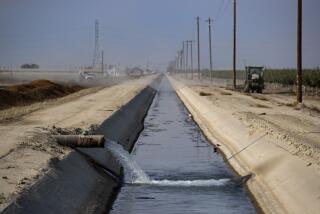Farmers Running Out of Green
- Share via
Farmers and ranchers seeking federal assistance to protect the environment are not benefiting from the millions of dollars in farm subsidies doled out annually by the U.S. Department of Agriculture, according to a study released Thursday by an environmental group.
Currently, California has a backlog of agricultural conservation projects totaling nearly $123 million. The state receives about $500,000 annually in USDA spending for conservation programs, according to the report.
Farmers in many areas say they are trying to operate more lightly on the land but lack financial support for wildlife protection, water pollution cleanup and saving farmland from urban sprawl. Thousands of farmers who seek federal assistance are turned away as more than $2 billion in conservation projects await funding, the study says.
The report was prepared by Environmental Defense, one of the nation’s largest environmental organizations. The report was released at a time when Congress is considering a new farm bill and other legislation that address, among other things, environmental protection on agricultural lands.
“Clearly, landowners are anxious to preserve open space, improve water quality and restore habitat for rare species,” said Environmental Defense attorney Scott Faber. Congress and the USDA “should provide sufficient funds to reward farmers, ranchers and private foresters when they need federal help to meet environmental challenges.”
Many of those concerns are echoed by farmers.
“There’s widespread agreement on placing more emphasis on conservation. It’s a shared perspective among farmers and conservationists,” said Don Lipton, a spokesman for the American Farm Bureau.
Among the report’s main findings:
* Seventy percent of the farmers and ranchers seeking USDA funds to help improve water quality are rejected due to inadequate funding.
* More than 3,000 farmers seeking to restore half a million acres of wetlands were rejected.
* Nine in 10 landowners offering to preserve open space by selling development rights were rejected.
* About 3,000 farmers and ranchers offering to create habitat on their land are being rejected.
Robert Ott grows cherries, walnuts and grapes at Bancroft Farms near Modesto. He says he tries to farm lightly on the land by preserving oak trees and reducing use of pesticides. Yet, after three years of trying, he is not able to secure $22,000 in federal funds to help pay for a drip irrigation system, which would reduce runoff and water pollution.
“There isn’t enough funding. The bottom line is USDA doesn’t fund these programs like they should be funded,” Ott said.
Kevin Herglotz, a spokesman for the USDA, said “We’ve certainly seen a lot of interest in conservation by farmers, and in some areas there has been more interest than funding.” Herglotz said that this year Congress approved funding for several USDA programs, including multi-state wetlands pilot projects in the Midwest and in the Northeast.
Farms and ranches cover about half of the American landscape and cause significant environmental damage, ranging from pollution from pesticides and fertilizers to soil erosion, smog and destruction of wildlife habitat.
To offset that damage, Congress is considering adding more money for conservation in the farm bill now going through hearings, and in the Working Lands Stewardship Act, which would provide $7 billion in annual conservation payments to farmers, ranchers and forest land owners. An additional $4 billion for conservation programs is being advanced in the Conservation Security Act, now before Congress.
More to Read
Sign up for Essential California
The most important California stories and recommendations in your inbox every morning.
You may occasionally receive promotional content from the Los Angeles Times.













